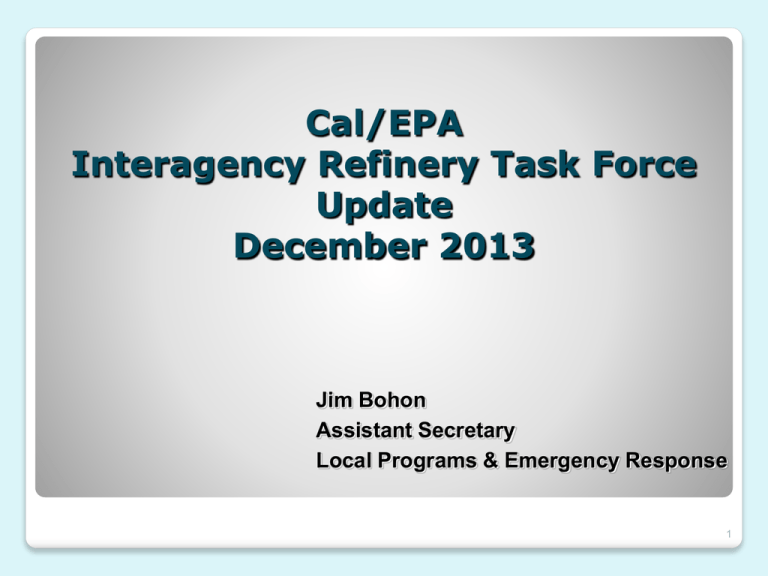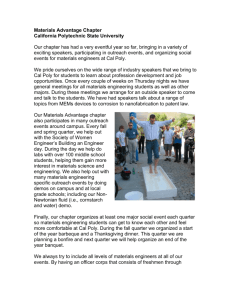Sonoma County FPO Presentation June 2010
advertisement

Cal/EPA Interagency Refinery Task Force Update December 2013 Jim Bohon Assistant Secretary Local Programs & Emergency Response 1 Governor’s Working Group Recommendation Categories Emergency management and response; 2. Safety and prevention; 3. Education and outreach to the public; 4. Improved agency coordination through the establishment of an Interagency Refinery Task Force. 1. Refinery Task Force Update Met August 30 ◦ Approved Charter ◦ Formed 2 Work Groups Met October 16 ◦ Approved Work Plans for the Work Groups ◦ Began Looking at Outreach Next meeting December 18 ◦ Work Group Updates ◦ CSB Report 3 Two Working Groups Formed Emergency Preparedness and Response ◦ Conveners: CalOES & CalEPA ◦ Meeting every week to 2 weeks Safety and Prevention ◦ Conveners: DIR CalOSHA & CalEPA ◦ Meeting every week to 2 weeks Work Plan Workgroup 1: Emergency Preparedness and Response A 1 2 3 4 A B C A B A Lead I. Refinery Annex for Area Plans Create a model refinery annex to Area Plans to include predefined radio communications between response officials and refineries, defined members of a Unified Incident Command, Joint Operation Center, and Joint Information Center, plans and protocols for transit agencies, medical facilities, large shopping centers and others, and requirements for joint exercises that include 2.1(a)(b)(c)( refineries' response resources. d) Develop structure for revisions WG CalOES, Cal/EPA, Concepts for regulatory language CUPAs Meetings with stakeholders TBD Work with CalOES on regulatory process TBD II. Other Emergency Response Actions Clarify reporting thresholds for releases or threatened releases. Tied to the legislative process of HSC Ch 6.95 Phase 2 changes 2.3 Greg Work with ARB and APCDs to support implemention of the "Air Monitoring for Vlasek, Accidental Refinery Releases: Potential Improvements" 2.1(e), 2.2 ARB Work with the California Air Response Planning Alliance to improve coordination of emergency response to airborne emergencies. 4.4 ARB III. Information Sharing and Coordination Develop guidelines for emergency communications between agencies to assure it is adequate in refinery emergencies. This includes public transporatation agencies, public works agencies, school districts, hospitals, and others. Work with federal, state and local response planning agencies to ensure that actions are coordinated across city, county, regional and bordering jurisdictional geographical areas. Use the stakeholders identified in the GO WG Report. IV. Public Outreach Plan Communicate to the public about the Task Force and workgroup Assist Cal OES and other state and local agencies in crafting a plan for aligning the LEPCs with county emergency management agencies and CUPAs B Develop material for website and factsheets (topics?) C Improve public involvement in air monitoring strategies D Gov. Report Reference 4th Quarter 2013 1st Quarter 2014 2nd Quarter 2014 3rd Quarter 2014 4th Quarter 2014 1st Quarter 2015 2nd Quarter 2015 Oct Nov Dec Jan Feb Mar Apr May Jun July Aug Sept Oct Nov Dec Jan Fed Mar Apr May Jun WG TBD w/Local 4.1 OES Offices WG TBD w/Local 2 OES Offices TBD Tom Campbell, 4.2 Cal OES Jim Bohon, 4.1 Cal/EPA Greg Vlasek, 4.3 ARB 5 Work Task Create a model refinery annex to Area Plans to include predefined radio communications between response officials and refineries, defined members of a Unified Incident Command, Joint Operation Center, and Joint Information Center, plans and protocols for transit agencies, medical facilities, large shopping centers and others, and requirements for joint exercises that include refineries' response resources. ◦ Develop concepts for regulatory language. ◦ Have meetings with stakeholders. 6 Work Plan Workgroup 2: Safety and Prevention D I. Revising PSM and CalARP Programs Revise PSM Program to include inherently safer systems, require safety culture assessments, incorporate damage mechanism hazard reviews into Process Hazard Analyses, require root cause analysis after significant accidents or releases, and account for human factors. Determine if PSM revisions should be regulatory or statutory Develop model structure for revisions Meetings with stakeholders Work with Cal/OSHA on regulatory or legislative process Revise CalARP Program to include inherently safer systems, require safety culture assessments, incorporate damage mechanism hazard reviews into Process Hazard Analyses, require root cause analysis after significant accidents or releases, and account for human factors. Determine if PSM revisions should be regulatory or statutory Develop model structure for revisions Meetings with stakeholders Work with OES on regulatory or legislative process Create requirement for annual refinery inspections in CalARP Develop and implement approach to improve refinery compliance, including criteria for formal enforcement and appropriate penalties A II. Areas for investigation Determine strategies to increase number of inspectors, support staff, and inspection frequency A 1 3 4 5 B 1 2 3 4 C B C D E F G H Determine ways to get more information from refineries on turnarounds, etc. Analyze patterns and trends in refineries' worker safety and environmental performance Conduct analysis of gaps and overlaps in agency authority Identify industry best practices at refineries and develop ways to encourage or require them Develop strategies for increasing worker involvement in refinery safety Develop plan for collection and use of leading and lagging indicators Investigate the Safety Case approach A B C D III. Interagency Data and Information Sharing Develop system to share data on inspections, compliance, injuries, emissions, and enforcement activity Address management of confidential information Identify components of the database that will be publicly available Create a system to allow agencies to share information about refinery-related complaints from all systems, including web-based complaint systems and call lines Develop and implement program for cross-training of inspectors IV. Public Outreach Plan Communicate to the public about the Task Force and workgroup Communicate to public and workers about complaint systems and hotlines Develop material for website and factsheets Plan and create Refinery Safety Forums A V. Coordination of Oversight and Enforcement Activities Develop the mechanism for coordinated oversight, including cross-referrals, training and joint inspections. A 1 2 B C Gov. Re por t Re fe r e nc e 4th Quarter 1st Quarter 2nd Quarter 3rd Quarter 4th Quarter 1st Quarter 2nd Quarter 2013 2014 2014 2014 2014 2015 2015 Oct Nov Dec Jan Feb Mar Apr May Jun July Aug Sept Oct Nov Dec Jan Feb Mar Apr May Jun 3.1(a), (b), (c), (d), (e) 3.1(a), (b), (c), (d), (e) 3.2 3.3(1) 3.3 3.3 1.1(c) 1.1(c) 3.5 3.4 3.6 1.1(d) 1.1(d) 1.1(d) 1.1(b) 1.1(b) 1.1(b) 1.3 7 1.1(a) Work Task Revise PSM Program to include inherently safer systems, require safety culture assessments, incorporate damage mechanism hazard reviews into Process Hazard Analyses, require root cause analysis after significant accidents or releases, and account for human factors. ◦ Determine if revisions should be regulatory or statutory. ◦ Develop model structure for revisions. 8 Refinery Information Officer Will be lead for coordinating efforts. Position has been established. Solicitation for applicants was made. Interviews are set. 9 10 11 Outreach South Coast AQMD Kern Co CUPA Contra Costa CAER 12 13






